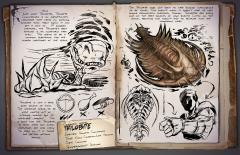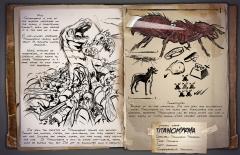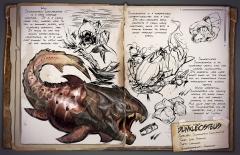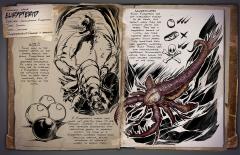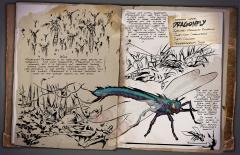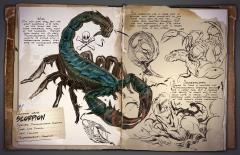Search the Community
Showing results for tags 'chitin'.
-
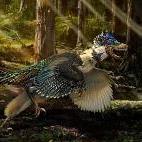
Linhenykus - a robust jackhammer with attitude
Mysfytt posted a suggestion in Creature submission archive
Creature suggestion: Linhenykus Common Name : Linhenykus Species : Linhenykus monodactylus (Alvarezsauridae) Time : Late Cretaceous Diet : Insectivore Temperament : Territorial Of the family group Alvarezsaurids a highly specialized form of theropod. They had long narrow heads with many small teeth, along with tiny but stout forelimbs, with compact, bird-like hands tipped with large heavy claws – most notable of these is the single clawed Linhenykus. Their skeletons suggest that they had massive breast and arm muscles, possibly adapted for digging or tearing into termite mounds, their ecological niches were similar to those of aardvarks, pangolins, and anteaters. Alvarezsaurids ranged from 50 centimetres (20 in) to 2 metres (6.6 ft) in length, although some possible members may have been larger, including the European Heptasteornis that may have reached 2.5 metres (8.2 ft) long. Fossils attributed to alvarezsaurids have also been found in North and South America and Asia, and range in age from about 86 to 66 million years ago. Size – The original size of the Linhenykus was so small it can fit in the palm of your hand, but ARK size can be more in line with the related Heptasteornis making it more Gallmimus sized so that it is rideable. The main feature of this dino is its single digit hand forming a single large almost jack-hammer like claw at the end of each arm. It was thought this was used to dig out termite mound and grubs. For a rideable ARK creature, this makes for an interesting weapon/gathering tool. Basically a robust jackhammer with attitude. Wild: – Similar to Iguanodon, these feathered bipedal dinos mosied around in singles or in pairs, stopping to peck at the ground occasionally and seeming to mind their own business. They look harmless, like a giant vegetarian compy or something Gallimimus related. That is until something else gets too close, then the big claws come out. Literally! With a fast side sweep and a double stabbing down motion -strike any predator is soon sorry to mess with this feisty dino. They are also not adverse in driving off any rivals in their perceived territory. Taming –Primary food is chitin same as the archaeopteryx making the traditional shooting with tranqs a little tricky but quite doable, then putting chitin in its inventory to eat. Alternatively the method could be centred around dropping its favourite food without making it agro and then either riding it bronco style and/or repeating the passive feeding. This way of course means if it agro’s for any reason it looses percentage making it a lot harder to tame. Domesticated: Once tamed a Linhenykus is quite rideableand proves to be a fast mount in keeping with a Gallimimus - but much more robust, and with those jack hammer claws it is more than capable of defending itself against most predators. While it is great as a long range scout with speed to boot, its fine bones means it cannot carry any great weights making not so useful for hauling gear. Those claws also make effective digging tools, making clearing land for farming or building a simple task of pointing it in the right direction and letting it hammer away. Abilities Attack - Single side sweep with one claw, plus a double claw stab in a downward motion (similar movement to the mantis attack) Harvest – Harvests chitin from all insect types extremely well. It will also harvest wood or stone while clearing these, but not as effectively as the Thorny or Doedi making chitin harvesting its main usage. It could also be used to dig up root vegetables such as rockarrots and savoroot. (whether from wild harvesting or only from gardens?? Would certainly obtain the seeds of these from bushes the same as a trike does.) Biome – Generally anywhere you find Gallimumus, mainly redwood, but also uncommon in forest area -
From the album: Dossiers
Common Name: Trilobite Species: Trilobite Conchadurus Time: Early Cambrian-Late Permian Diet: Carnivore Temperament: Defensive Wild: Like most Trilobites, Trilobite Conchadurus is an opportunistic carnivore that feeds on anything smaller than itself which it can get a hold of. A sluggish creature, the Trilobite's best defense is its incredibly hard shell. This seems to be a common adaption for the slower creatures of the island. Trilobite is not a very good source of food. The creature seems to be made mostly out of internal organs and its defensive carapace. This is good for the Trilobite, as both river and ocean predators are less likely to prey on it if there are better options around. Domesticated: The Trilobite does not seem to have enough intelligence to be tamed. This doesn't mean it doesn't have its uses among resourceful survivors, though. Trilobites are easily one of the best sources of high quality chitin on the island, assuming one doesn't wish to venture into the dangerous caves. Known Information: Trilobite is not a very good source of food. The creature seems to be made mostly out of internal organs and its defensive Carapace. This is good for the Trilobite, as both river and ocean predators are less likely to prey on it if there are better options around. -
From the album: Dossiers
Common Name: Titanomyrma Species: Titanomyrma parvagigan Time: Paleogene Diet: Herbivore Temperament: Territorial Wild: Titanomyrma is one of the smaller creatures on the island; A frightening thought, when you realize it is the size of a dog. A hive-minded herbivore, Titanomyrma usually goes about it's business unless provoked. When attacked or threatened, it releases a chemical which alerts all Titanomyrma in a large range to help fight the aggressor. I've seen two varieties of Titanomyrma: Drones and soldiers. Drones are smaller, faster and land-bound, and they harvest for the hive. Soldiers are larger, slower and have wings; They defend the hive. If Titanomyrma is akin to other hive-insects, there must be Queens too, but I've yet to encounter such a variant. Domesticated: Because of its hive mentality, I've not seen any successfully tamed Titanomyrma on the island yet. Fortunately for lone survivors, separated Titanomyrma can be easily picked off for a small supply of Chitin among other valuable natural resources.- 1 comment
-
- titanomyrma
- ant
- (and 7 more)
-
From the album: Dossiers
Common Name: Dunkleosteus Species: Dunkleosteus Loricaruptor Time: Late Devonian Diet: Carnivore Temperament: Aggressive Wild: Dunkleosteus Loricaruptor is a very strange creature. It is a fairly large fish, covered head to tail in armored plates, with incredibly powerful jaws. It tends to eat the islands' water-dwelling crustaceans, as it not fast enough to catch most of the smaller fish. Dunkleosteus is a surprisingly combat-oriented for a fish. Its well-armored body protects it from many creatures, while its bite is strong enough to easily crush through chitinous shells. Domesticated: Dunkleosteus is an incredibly useful fish for coastal communities. Its powerful jaws make short work of the stone and oil formations found throughout the oceanic depths. While harvesting, Dunkleosteus can handily defend its rider from all but the largest threats in the waters. And once past its prime, the Dunkleosteus can be harvested for a fair amount of Chitin.-
- dunkleosteus
- fish
-
(and 6 more)
Tagged with:
-
From the album: Dossiers
Common Name: Eurypterid Species: Jaekelopterus Euryperus Time: Silurian Diet: Carnivore Temperament: Aggressive if approached Wild: Found only in the deepest depths of the waters around the island, Eurypterids are dangerous and adaptable Arthropods. As likely to hunt as they are to scavenge, a Eurypterid rarely has difficulty finding food to keep itself nourished, even at the bottom of the ocean. A Eurypterid’s threat does comes not directly from its raw strength. Instead, it combines a hard defensive exoskeleton with debilitating poison to powerful effect. The sting of a Eurypterid increases torpor while reducing stamina, quickly rendering its opponent unable to defend itself. Domesticated: While Eurypterid are not intelligent enough to be tamed, this doesn't mean they are without utility for tribes. They are a wonderful source of Chitin, and their digestive tract often contain Silica Pearls. They sometimes even have incredibly rare Black Pearls used for manufacturing mysterious technologies, making them among the most valuable creatures on the island.-
- eurypterid
- invertebrate
- (and 7 more)
-
From the album: Dossiers
Common Name: Dragonfly Group: Invertebrates Species: Meganeura quatpenna Time: Late Carboniferous Diet: Carnivore Temperament: Docile Wild: Meganeura quatpenna is an especially large species of dragonfly. Actually, it is a type of griffinfly, an extinct species of invertebrate that looked similar to dragonflies. Like most griffinflies, Meganeura is carnivorous, but it is typically not aggressive towards humans unless provoked or challenged for food. It lives primarily in the wetter, heavily wooded areas, such as the jungles. Meganeura is a natural predator of most of the smaller insects on the island. Though not often aggressive, Meganeura will not turn down a free meal. They quickly appear in large numbers to scavenge off the victims of Pulmonoscorpius, rendered unconscious and unable to defend themselves. Of course the insects do have to avoid the Pulmonoscorpius itself. I have noticed it is unwise to disturb a flock of feeding Meganeura. The size of the insects on the island confounds me. The way these creatures diffuse oxygen should limit their size but Meganeura (and other bugs) seem to be able to advance beyond this restraint. If there is more oxygen in the air this could explain Meganeura's growth.-
- invertebrate
- meganeura
- (and 8 more)
-
From the album: Dossiers
Common Name: Scorpion Species: Pulmonoscorpius gigantus Time: Late Silurian Diet: Carnivore Temperament: Aggressive Wild: I'm not sure why, but the giant scorpions I've seen on the island are far more disturbing than most of the Dinosaurs. Rather than simply kill its prey, Pulmonoscorpius gigantus injects its victims with a tranquilizing poison, then eats its unconscious prey alive. This subspecies has a large pair of pincers that seem connected to the same toxin sacs as the tail. I've never seen another scorpion that has this adaptation, but I've never seen another scorpion that is larger than I am, either. Domesticated: Trying to tame a monster like Pulmonoscorpius gigantus sounds like a crazy idea, but I suppose the ability to knock out a foe could come in handy. It could certainly make incapacitating some of the island's other creatures much easier.-
- carnivore
- late silurian
- (and 8 more)
